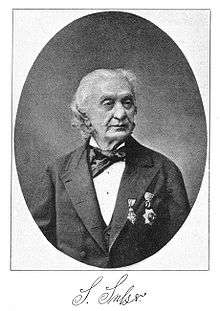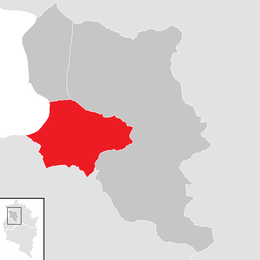Hohenems
| Hohenems | ||
|---|---|---|
|
Town centre | ||
| ||
 Hohenems Location within Austria | ||
Location within Dornbirn district
| ||
| Coordinates: 47°22′00″N 09°40′00″E / 47.36667°N 9.66667°ECoordinates: 47°22′00″N 09°40′00″E / 47.36667°N 9.66667°E | ||
| Country | Austria | |
| State | Vorarlberg | |
| District | Dornbirn | |
| Government | ||
| • Mayor | Dieter Egger (FPÖ) | |
| Area | ||
| • Total | 29.18 km2 (11.27 sq mi) | |
| Elevation | 432 m (1,417 ft) | |
| Population (1 January 2016)[1] | ||
| • Total | 15,941 | |
| • Density | 550/km2 (1,400/sq mi) | |
| Time zone | CET (UTC+1) | |
| • Summer (DST) | CEST (UTC+2) | |
| Postal code | 6845 | |
| Area code | 05576 | |
| Vehicle registration | DO | |
| Website | www.hohenems.at | |
Hohenems is a town in the Austrian state of Vorarlberg in the Dornbirn district. It lies in the middle of the Austrian part of the Rhine valley. With a population of 15,200 it is the fifth largest municipality in Vorarlberg. Hohenems' attractions include a Renaissance palace dating back to the 16th century and a Jewish museum.
Geography
The town is located at 432 metres (1,417 feet) above sea level, about 16 km (10 miles) south of Lake Constance. Hohenems extends for 5.5 km (3.4 mi) from north to south and 8.2 km (5.1 mi) from west to east. Its total area is 29 square kilometres (11 sq mi), of which 42% is covered with forest. The oxbow lake of the river Rhine in the west, forming the border of Austria as well as EU to Switzerland, and the mountainside in the east implies the narrowest point of the Austrian Rhine valley. The Schlossberg ("castle mountain"), elevation 740 metres (2,428 feet), depicts a distinctive backdrop of the town centre.
Hohenems is subdivided into the neighborhoods of Markt (centre), Oberklien and Unterklien (north), Hohenems-Reute (east), Schwefel (south) and Herrenried (west). It is surrounded by six other municipalities, Lustenau and Dornbirn in the Dornbirn district (north and east), Fraxern, Götzis and Altach in the Feldkirch district (south) and Diepoldsau in the Swiss canton St. Gallen (west).
History
The summit of the Schlossberg rock, within 45 minutes walk from town centre, hosts the ruins of Alt-Ems, a castle dating back to the 9th century. From the 12th century it was among the biggest fortifications in the south of the German kingdom.[2] The stronghold was very strung-out and extended up to 800 m (2,625 ft) in length and 85 m (280 ft) in width. The lords and knights of Hohenems resided there, being at the peak of fame from 13th to 16th century. As they were loyal ministeriales of the Hohenstaufen dynasty, the castle served for the arrest of notable prisoners like the Norman king William III of Sicily, who probably died here in 1198.
The first time Hohenems received the rights and liberties of a city (German Stadtrecht) already was in 1333, but the town never made use of this municipal law. Only at the 650th anniversary of the Stadtrecht, in 1983, the government of Vorarlberg entitled Hohenems to all city rights.
On a crest near Alt-Ems the Burg Neu-Ems (also "Schloss Glopper") is located, built in 1343. In 1407 both castles were destroyed during the Appenzell Wars and rebuilt shortly afterwards. Burg Neu-Ems is still intact today and in the private property of the Waldburg-Zeil family.

The Renaissance palace stands at the foot of the Schlossberg and dominates the main square of town, the Schlossplatz. It was built from 1562 to 1567 under the direction of architect Martino Longhi the Elder. Religious war and the plague devastated the area in the next century, ironically the time of the greatest power of the (Protestant) Counts of Hohenems, when they acquired Vaduz Castle from what became Liechtenstein nearby.[3] In the 18th century Hohenems was noted for the discovery of two manuscripts of the Nibelungenlied, found in 1755 and 1779 in the palace's library.[4]
Jewish heritage
The Jewish community in Hohenems began with a charter in 1617 and a synagogue, a ritual bath (mikvah), a school and a poorhouse were built. A cemetery was established on the southern outskirts of town. The first coffee house in 1797, and in 1841, the first bank and insurance company in Vorarlberg, were the result of the Jewish economic activity in the town. The community reached its peak in 1862, with nearly 600 Jewish citizens living in Hohenems, 12% of the population. The Jewish presence in town was terminated in 1942 with the deportation of the last remaining Jew, Frieda Nagelberg. Recently 3 more have moved in.

Although the synagogue survived Kristallnacht without damage, it was acquired by the municipality after the war and converted into a fire station. Everything pertaining to its uses as a synagogue was removed or destroyed, a condition that continued until 2001, when the synagogue was partly reconstructed.[5] The Jewish quarter, which has had historical preservation status since 1996, consists of numerous townhouses and mansions surrounding the synagogue. Along with the former Christengasse ("Christian Lane"), renamed Marktstrasse (Market Street), it forms the urban core of Hohenems.
In 1991, the Jewish Museum Hohenems was opened in a mansion in the centre of the Jewish quarter. The museum commemorates the history of the Jewish community in Hohenems. The few remaining objects it presents, predominantly two-dimensional, are testament to the elimination of all Jewish traces in Vorarlberg. The Jewish cemetery south of the town dates to the first Jewish settlement in 1617 and is still in use today. It contains more than 500 graves, 370 gravestones of which survive today.[6]
Population
| Historical population | ||
|---|---|---|
| Year | Pop. | ±% |
| 1869 | 4,191 | — |
| 1880 | 4,428 | +5.7% |
| 1890 | 4,972 | +12.3% |
| 1900 | 5,652 | +13.7% |
| 1910 | 6,456 | +14.2% |
| 1923 | 5,153 | −20.2% |
| 1934 | 5,514 | +7.0% |
| 1939 | 5,734 | +4.0% |
| 1951 | 6,990 | +21.9% |
| 1961 | 9,188 | +31.4% |
| 1971 | 11,487 | +25.0% |
| 1981 | 12,666 | +10.3% |
| 1991 | 13,531 | +6.8% |
| 2001 | 13,891 | +2.7% |
| 2011 | 15,149 | +9.1% |
Infrastructure
Apart from the historical sites, the town centre lacks urban ambience, although hotels, shops, and restaurants can be found there. On the outskirts near the motorway can be found branches of multinational retail chains and a ten-screen multiplex. On the way to Hohenems's mountain village, Reute, the Stoffels Säge-Mühle ("Stoffel's Sawmill") Museum can be found, which presents the history of saw milling and mill grinding technologies.
Hohenems has several leisure facilities. In the mountain area there is a small ski resort (Schuttannen alp) and a rock climbing area called Löwenzähne ("lion's teeth") with walls up to 150 m (500 ft) and level 10. There also is a range of hiking and mountain biking routes. The town owns the biggest recreation and leisure centre (13 hectare) in Vorarlberg,[7] situated at the banks of the river Rhine's oxbow lake.
Since 1908 there is a hospital in Hohenems, when the Kaiserin-Elisabeth-Krankenhaus ("Queen Elisabeth hospital") was built in Art Nouveau. It hosts the palliative care unit of the provincial hospital today, which in 1972 was put up in form of a concrete block, contiguous to the old one. After long discussions, also the first crematory in the state of Vorarlberg was erected in 1998.
Transport
Two state roads, the Vorarlberger Strasse L190 and the Rheinstrasse L203 are crossing the municipality from north to south. The L46 leads from town centre to customs to Switzerland. Hohenems has motorway access to the Rheintal/Walgau-Autobahn (Austrian A14/European route E60) and connection to the Vorarlbergbahn railway line in directions Bregenz and Innsbruck, operated by the Austrian Federal Railways (ÖBB). Within municipal borders the sole airfield of Vorarlberg is located, the Flugplatz Hohenems-Dornbirn with a 630 m (2,066 ft) runway.[8]
Trivia
Hohenems was one of the locations in the Swiss-Austrian film Akte Grüninger.[9][10]
The town is the site of the climax of Dennis Wheatley's novel about the 1914 outbreak of the First World War, The Second Seal(1950).
Twin towns
Hohenems is twinned with
![]() Bystré and Polička in the Czech Republic (since 1997) [11]
Bystré and Polička in the Czech Republic (since 1997) [11]
Notable persons
- Jean Améry, (1912-1978), resistance fighter against Nazism, essayist
- Matthias Brandle, (born 1989), professional cyclist
- Rudolf von Ems (1200-1254), medieval poet and minstrel
- Adi Hütter (born 1970), football player and coach
- Christian Klien, (born 1983), Formula One Racing Driver
- Michael Köhlmeier, (born 1949), Austrian writer and musician
- Marcel Mathis (born 1993), alpine skier
- Harald Morscher (born 1972), cyclist
- Ramazan Özcan, (born 1984), football goalkeeper
- Hans Jörg Schelling (born 1953), entrepreneur, politician (ÖVP) and Federal Minister of Finance
- Mark Sittich von Hohenems (Prince-Archbishop of Salzburg) (1574-1619), Archbishop of Salzburg

- Salomon Sulzer (1804-1890), Reform cantor and composer
- Bernhard Vogel (1913-2000), politician, Member of Parliament and Federal Council (SPÖ)
- Wolfram Waibel Jr. (born 1970), Austrian sport shooter
- Eckart Witzigmann (born 1941), cook, awarded three stars in Michelin
Notes
- ↑ Statistik Austria - Bevölkerung zu Jahresbeginn 2002-2016 nach Gemeinden (Gebietsstand 2016-01-01), 2016-01-01.
- ↑ Tiscover: Ruin Alt-Ems
- ↑ http://tips.fm/entry.php?1118-Liechtenstein-The-Counts-of-Hohenems-1613-1712
- ↑ Nibelungenlied, The. eBooks@Adelaide. Shumway, Daniel B. (trans.). Houghton–Mifflin. 1909.
The honor of rediscovering the “Nibelungenlied” and of restoring it to the world of literature belongs to a young physician by the name of J.H. Obereit, who found the manuscript C at the castle of Hohenems in the Tirol on June 29, 1755.
- ↑ Synagogue Jewish Museum Hohenems, official website.
- ↑ Jewish cemetery Jewish Museum Hohenems, official website. Retrieved July 8, 2010
- ↑ Tiscover: Rheinauen
- ↑ www.loih.at: Flugplatz Hohenems-Dornbirn
- ↑ Ingrid Bertel (2014-01-29). ""Akte Grüninger": Filmpremiere in Hohenems" (in German). ORF (broadcaster). Retrieved 2014-10-20.
- ↑ "Akte-Grüninger. Geschichte eines Grenzgängers" (in German). Nationalsozialismus und Holocaust (erinnern.at). Retrieved 2014-10-20.
- ↑ Website of Hohenems - Sistercities: Bystre and Policka
External links
| Wikimedia Commons has media related to Hohenems. |

